
- •Preface
- •Content
- •Tissues
- •Nerve Tissue
- •Skin - Epidermis
- •Skin - Dermis
- •Skin - Glands
- •Subcutaneous Layer
- •Skeleton
- •Axial Skeleton
- •Cranium
- •Cranial Bones – Inferior Nasal Concha
- •Vertebral Column
- •Sacrum and Coccyx
- •Ribs
- •Sternum
- •Clavicle
- •Scapula
- •Humerus
- •Ulna
- •Radius
- •Metacarpals and Phalanges
- •Pelvis - Male
- •Femur
- •Tibia
- •Fibula
- •Tarsal Bones - Cuboid and Navicular
- •Phalanges
- •Patella
- •Skeletal Muscles
- •Transversospinales Muscles
- •Cervical Hypaxial Muscles
- •Thoracic and Abdominal Hypaxial Muscles
- •Shoulder Muscles - Rotator Cuff
- •Shoulder Muscles - Prime Movers
- •Anterior Brachial Muscles
- •Posterior Brachial Muscles
- •Posterior Thigh Muscles
- •Thigh Muscles
- •Lateral Leg Muscles
- •Posterior Leg Muscles
- •Spinal Nerves
- •Dorsal Rami
- •Intercostal Nerves
- •Cutaneous Nerves
- •Autonomic Nerves
- •Spinal Cord
- •Brain
- •Cerebrum
- •Cerebellum
- •Meninges
- •Hypothalamus
- •Pituitary Gland
- •Pineal Gland
- •Thymus
- •Pancreas
- •Ovaries
- •Testes
- •Blood
- •Heart
- •Lymphatics
- •Larynx
- •Lungs
- •Cast of Trachea and Bronchial Tree
- •Esophagus
- •Stomach
- •Pancreas
- •Large Intestine
- •Mesenteries
- •Omenta
- •Female Reproductive Organs
- •Ovary
- •Vagina
- •Ductus Deferens and Spermatic Cord
- •Penis
- •Index

Hypothalamus The hypothalamus occupies the area of the brain between the third ventricle and the subthalamus. It is
a major intersection between the thalamus, cerebral cortex, and ascending fi ber systems from the spinal cord and brainstem. It is the control center of the autonomic nervous system and regulates the function of numerous endocrine glands. The posterior pituitary gland, or neurohypophysis, is an outgrowth of the hypothalamus. Many factors infl uence the hypothalamus and dictate its controlling infl uence over tissues in the body. These factors include the nervous input that enters it, temperature, osmotic pressure, and levels of hormones in the circulating blood that pass through its capillaries.
1 |
Hypothalamus |
9 |
Midbrain |
2 |
Pineal gland |
10 |
Pons |
3 |
Frontal lobe of cerebrum |
11 |
Cerebellum |
4 |
Parietal lobe of cerebrum |
12 |
Medulla oblongata |
5 |
Occipital lobe of cerebrum |
13 |
Lateral ventricle |
6 |
Temporal lobe of cerebrum |
14 |
Fourth ventricle |
7 |
Corpus callosum |
15 |
Mammilary body |
8 |
Thalamus |
16 |
Spinal cord |
4
7
3
13
8
2
1
15 |
5 |
9
6
11
10
14
12
16
Sagittal section of brain
Medial view
250
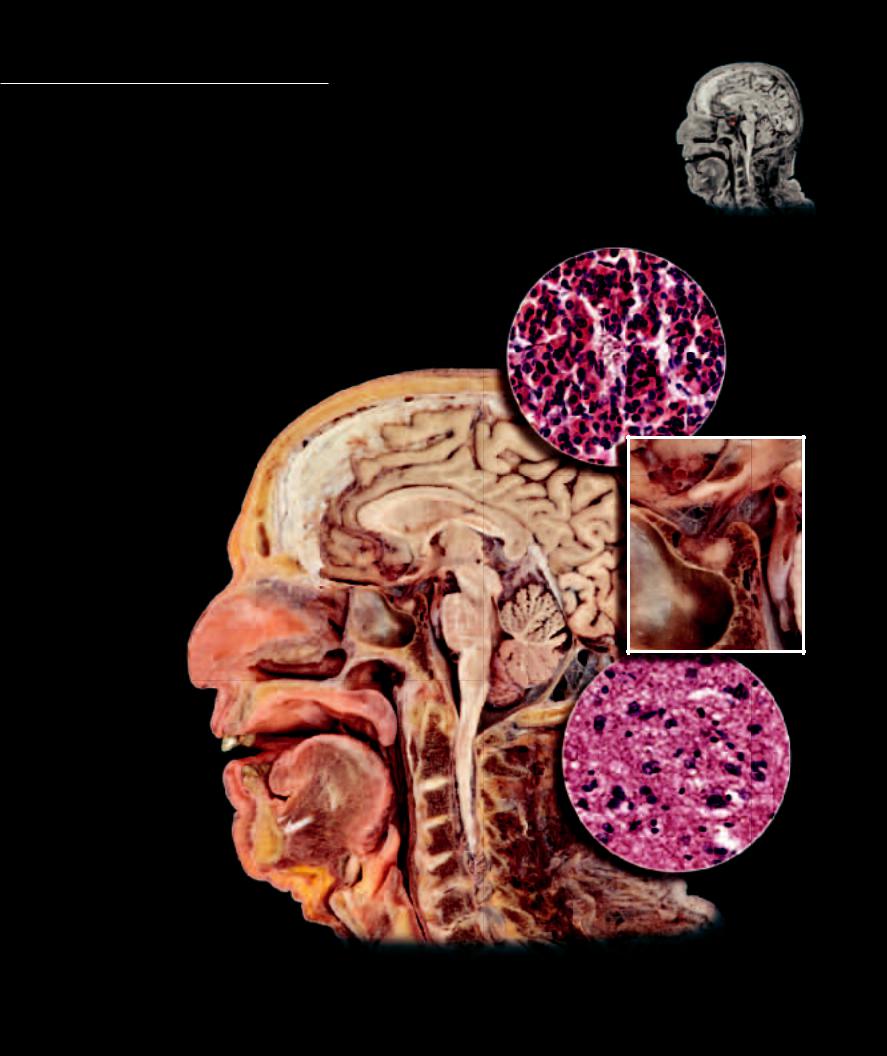
The pituitary gland, or hypophysis, “hangs” from the base of the brain via a connecting stalk, the infundibulum, which connects it to the hypothalamus. The infundibulum
contains numerous nerve fibers that relay from the hypothalamus to the posterior portion of the pituitary gland. In addition to this nervous pathway between the hypothalamus and the pituitary, numerous small blood vessels pass between the two organs. The pituitary gland has two anatomically and functionally distinct lobes, the neurohypophysis (posterior lobe) and the adenohypophysis (anterior lobe). The posterior lobe arises as an outgrowth of the embryonic brain. It is composed of nervous tissue and forms a neural link with the hypothalamus through the infundibulum. The anterior lobe arises from the epithelial lining of the embryonic pharynx. It consists of glandular epithelial tissue and forms a vascular link with the hypothalamus via the small blood vessels that pass between the two regions.
1 |
Pituitary gland |
|
|
2 |
Infundibulum |
Photomicrograph of anterior pituitary |
|
3 |
Adenohypophysis |
200x |
|
4 |
Neurohypophysis |
||
|
5Parenchyma consisting of acidophils, basophils, and chromophobes
6 Capillary with red blood cells
7 Parenchyma consisting of 5 6 axons and pituicytes
8 Hypothalamus
9 Cerebrum
10Falx cerebri
11Midbrain
12Pons
13 |
Cerebellum |
9 |
8 |
|
14 |
Medulla oblongata |
|||
|
|
|||
15 |
Spinal cord |
10 |
|
16Nasal septum
17Soft palate
18 Tongue |
2 |
19Epiglottis
20Atlas
21 |
Axis |
|
|
|
3 |
4 |
|
8 |
|
|
|||
22 |
Intervertebral disc |
|
11 |
|
|
|
23 |
Sphenoid sinus |
|
|
|
|
|
24 |
Occipital bone |
|
1 |
|
|
|
|
|
|
|
|
|
|
|
16 |
23 |
|
12 |
|
|
|
|
|
|
13 |
|
|
|
|
|
|
|
|
|
|
|
|
|
14 |
|
|
|
|
17 |
20 |
|
24 |
|
|
|
|
|
|
||
|
|
|
|
|
|
|
|
|
|
|
|
20 |
|
|
|
|
21 |
15 |
7 |
|
|
|
|
|
|
||
|
|
18 |
22 |
|
|
|
|
|
|
|
|
|
19
Photomicrograph of posterior pituitary
200x
Sagittal section of head and neck with enlarged callout of pituitary gland
Medial view
251

The pineal gland, a small reddish-gray body covered with pia mater, is a midline epithelial outgrowth of the embryonic midbrain positioned in a depression between the two superior
colliculi on the midbrain’s dorsal surface. The distal end of this outgrowth becomes a small mass of secretory cells that resemble the shape of a pine cone. It is from this appearance that it derives its name. The pia mater sends septa into the pineal gland that divide it into cords of secretory cells that are intermingled with numerous blood capillaries. The secretory cells of the pineal gland, called pinealocytes, have arm-like processes that contact both neighboring capillaries and the ependymal cells that line the third ventricle. Hormonal secretions produced in the body of the cell are moved through the arm-like processes where they are released by exocytosis into the capillaries and cerebrospinal fluid. Projecting into these cords of tissue are sympathetic postganglionic neurons from the superior cervical sympathetic ganglion. The gland plays a role in integrating photoperiod and affecting circadian rhythms.
1 |
Pineal gland |
|
|
2 |
Adenohypophysis |
|
|
3 |
Neurohypophysis |
10 |
|
4 |
Thalamus |
||
11 |
|||
5 |
Superior colliculi |
||
|
|||
6 |
Inferior colliculi |
|
|
7 |
Medial geniculate nucleus |
|
|
8 |
Cerebral peduncle |
|
|
9 |
Medulla oblongata |
|
|
10 |
Falx cerebri |
|
|
11 |
Corpus callosum |
1 |
12Pons
13Cerebellum
14Sphenoid sinus
15 |
Occipital bone |
2 |
3 |
|
16 |
Atlas |
|
||
|
|
|
||
17 |
Axis |
|
12 |
13 |
18 |
Soft palate |
14 |
19Nasopharynx
20Tongue
21Middle cerebellar peduncle
22 Fourth ventricle |
|
|
15 |
9 |
|
|
|
15 |
|
|
|
|
|
|
|
4 |
|
19 |
|
|
|
|
|
|
|
|
1 |
16 |
|
|
|
18 |
|
|
|
5 |
|
16 |
|
7 |
|
|
|
8 |
17 |
|
|
|
6 |
|
20 |
|
|
Sagittal section of brainstem and diencephalon in situ
Medial view
21 22
9
Dissection of brainstem and diencephalon
Posterior view
252
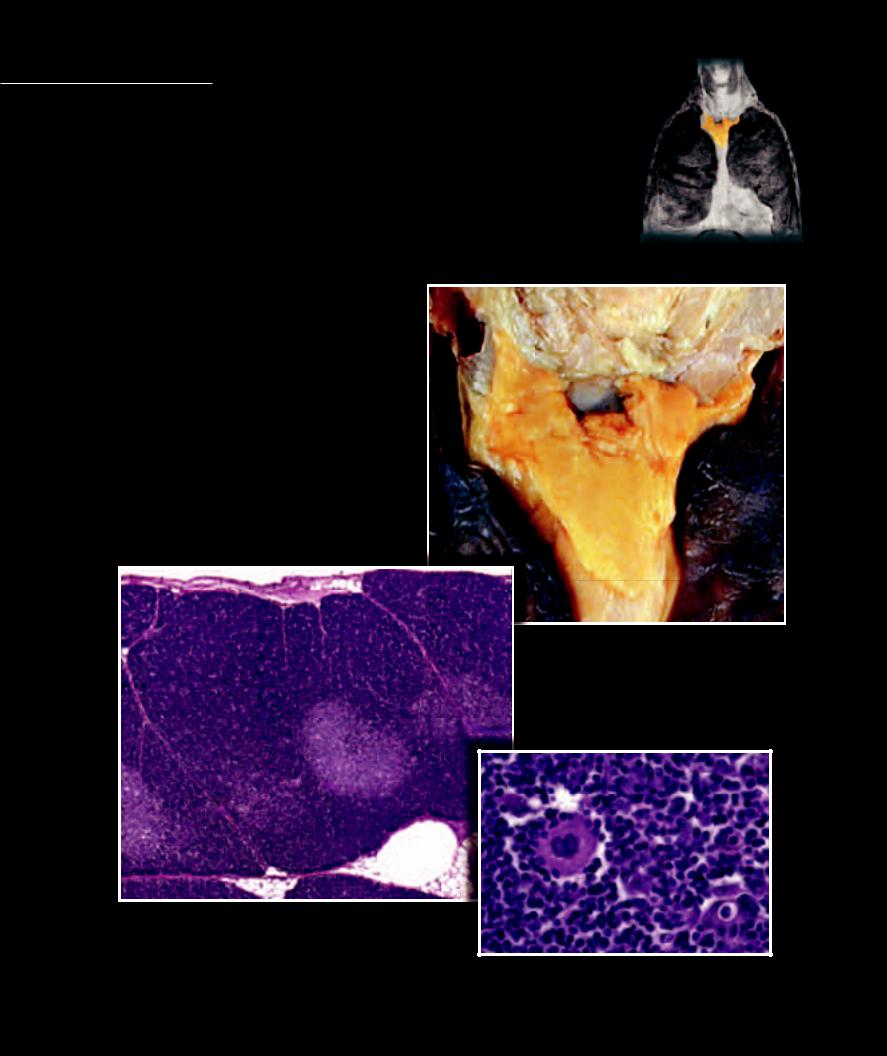
Thymus The thymus is one of the primary lymphoid organs, but it also has an endocrine component. The thymus provides the specialized environ-
ment for the precursor T cells to develop, differentiate, and undergo clonal expansion. This bilobed organ sits just posterior to the superior sternum along the midline. It spans from the top of the sternum, sometimes even projecting into the inferior cervical region, to the level of the fourth costal cartilages and sits anterior to the top of the heart and its great vessels. It has an outer fi brous capsule that sends fi brous septa, connective tissue walls, into the organ forming small lobular subregions. The thymus was once thought to diminish in size with age, but in actuality it does not. Because of its high content of lymphoid tissue and a rich blood supply, it has a reddish appearance in a living body. With age, however, fatty infi ltrations replace the lymphoid tissue and it takes on more of the yellowish color of the invading fat. This gives it the false appearance of a reduction in size. The thymus produces hormones that promote the maturation of T cells and may help retard the aging process.
1 Thymus
2 Thymic cortex
3 Thymic medulla
4 Trabeculae
5 Capsule
6 Maturing T cells
7 Epithelioreticular cell
8 Thymic corpuscle
9 Right lung
10 Left lung
1 |
10 |
9
5 |
|
|
|
|
4 |
2 |
|
|
|
|
|
2 |
|
Thymus in situ |
|
|
|
Anterior view |
|
4 |
|
3 |
|
|
3 |
|
|
|
|
6 |
|
3 |
|
|
|
|
|
8 |
7 |
Photomicrograph of thymus |
7 |
6 |
50x
Photomicrograph of thymus
400x
253
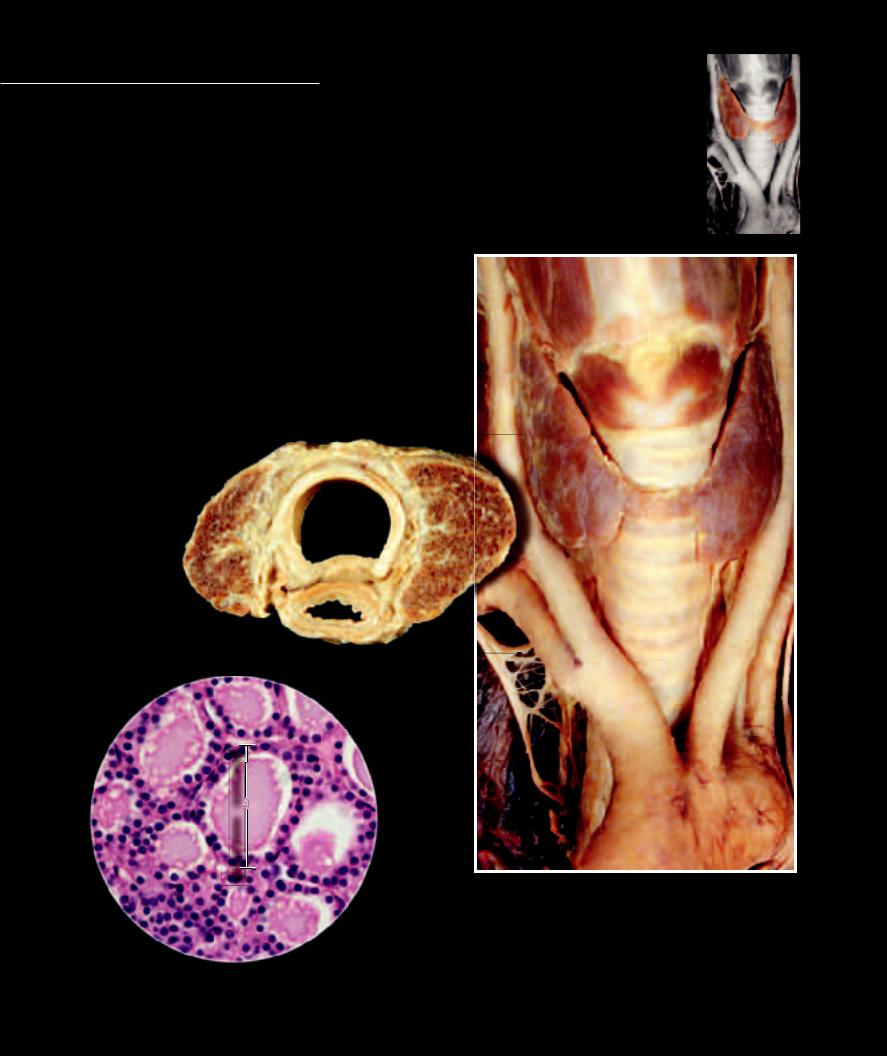
The thyroid gland is a bilobed organ positioned in the anterior neck. This highly vascular organ consists of two lateral lobes of endocrine tissue joined in the middle by a narrow portion of the
gland called the isthmus. It is red-brown in color and is enveloped by a thin layer of connective tissue. This connective tissue capsule sends extensions into the gland that divide the vascular and epithelial core into masses of irregular shape and size. The epithelial cells within the compartments of the thyroid gland form the secretory tissues of the organ. The major thyroid secretory cells are arranged into hollow spheres, each of which forms a functional unit called a follicle. In a microscopic section the follicles appear as rings of follicular cells enclosing an inner lumen fi lled with colloid, a substance that serves as an extracellular storage site for thyroid hormones. Interspersed in the interstitial spaces between the follicles are other secretory cells, the C cells, so called because they secrete the peptide hormone calcitonin.
1 |
Right lobe of thyroid gland |
|
|
|
|
|
|
||
2 |
Left lobe of thyroid gland |
|
|
|
|
|
|
||
3 |
Isthmus of thyroid gland |
|
|
|
19 |
11 |
|||
4 |
Thyroid follicle |
|
|
|
|
||||
|
|
|
|
|
|
||||
5 |
Follicular cell |
|
|
|
|
|
|
||
6 |
Thyroglobulin (TGB) |
|
|
|
|
|
|
||
7 |
Parafollicular (C) cell |
|
|
|
|
|
|
||
8 |
Trachea |
|
|
|
|
|
|
||
9 |
Fibromuscular membrane of trachea |
|
|
|
|||||
10 |
Esophagus |
|
|
|
|
|
|
||
11 |
Thyroid cartilage |
|
|
|
|
|
13 |
||
12 |
Cricoid cartilage |
|
|
|
|
|
|||
|
|
|
|
|
|
||||
13 |
Cricothyroid muscle |
|
|
|
|
|
12 |
||
14 |
Brachiocephalic artery |
|
|
|
|
|
|
||
15 |
Common carotid |
artery |
|
|
|
|
|
|
|
16 |
Subclavian artery |
|
|
|
1 |
2 |
|||
17 |
Aortic arch |
|
|
|
|||||
8 |
|
|
|
||||||
18 |
Vagus nerve |
|
|
|
|||||
|
|
|
|
|
|
||||
19 |
Thyrohyoid muscle |
|
|
|
|
|
|
||
|
|
|
|
|
|
|
|
|
3 |
|
1 |
|
|
|
2 |
|
|
||
|
|
|
|
9 |
|
|
8 |
||
|
|
|
|
|
|
|
15 |
||
|
|
|
|
|
|
|
15 |
||
|
|
|
|
10 |
|
|
|||
|
|
|
|
16 |
|
||||
|
|
|
|
|
|
|
18 |
16 |
|
|
|
|
|
|
|
|
|
|
|
|
|
|
|
|
Transverse section of thyroid gland |
|
|
|
|
|
|
|
|
|
|
Inferior view |
|
|
|
|
|
|
|
|
|
|
|
|
14 |
|
|
|
|
|
|
|
|
|
18 |
|
6 |
|
|
|
|
7 |
|
|
|
|
|
|
|
|
|
|
|
||
|
5 |
|
|
|
|
|
|
||
|
|
|
|
|
|
|
|||
|
|
|
|
|
|
|
|
|
|
|
5 |
|
|
4 |
|
|
|
|
|
|
|
|
|
|
|
|
|
17 |
|
|
|
|
|
|
|
|
|
|
|
5
Thyroid gland in situ
Anterior view
Photomicrograph of thyroid gland
240x
254
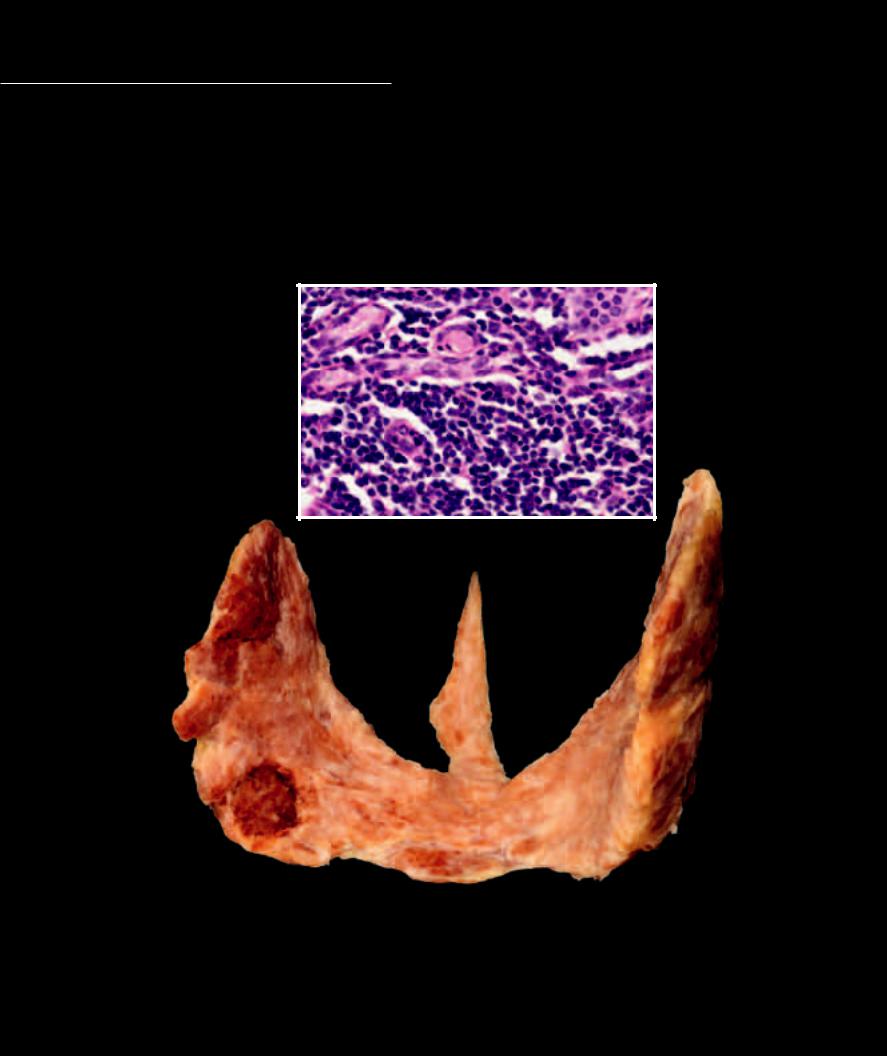
The parathyroid glands are small, oval, light brown glands situated on the posterior border of the two lateral lobes of the thyroid gland. The parathyroid glands sit just beneath the connective tissue capsule
of the thyroid gland. There are four parathyroid glands, two superior and two inferior. The endocrine cells of the parathyroid glands are called chief or principal cells. The chief cells form interconnecting columns of cells separated by fenestrated capillaries. The chief cells produce the parathyroid hormone.
1 |
Superior parathyroid gland |
7 |
Chief cell |
2 |
Inferior parathyroid gland |
8 |
Oxyphil cell |
3 |
Left lobe of thyroid gland |
9 |
Capillary |
4 |
Right lobe of thyroid gland |
10 |
Arteriole |
5 |
Isthmus of thyroid gland |
11 |
Venule |
6 |
Pyramidal lobe of thyroid gland |
|
|
8
11
10
9
7
Photomicrograph of parathyroid gland
240x
1
6
3
4
2
5
Thyroid and parathyroid glands (exposed on left)
Posterior view
255
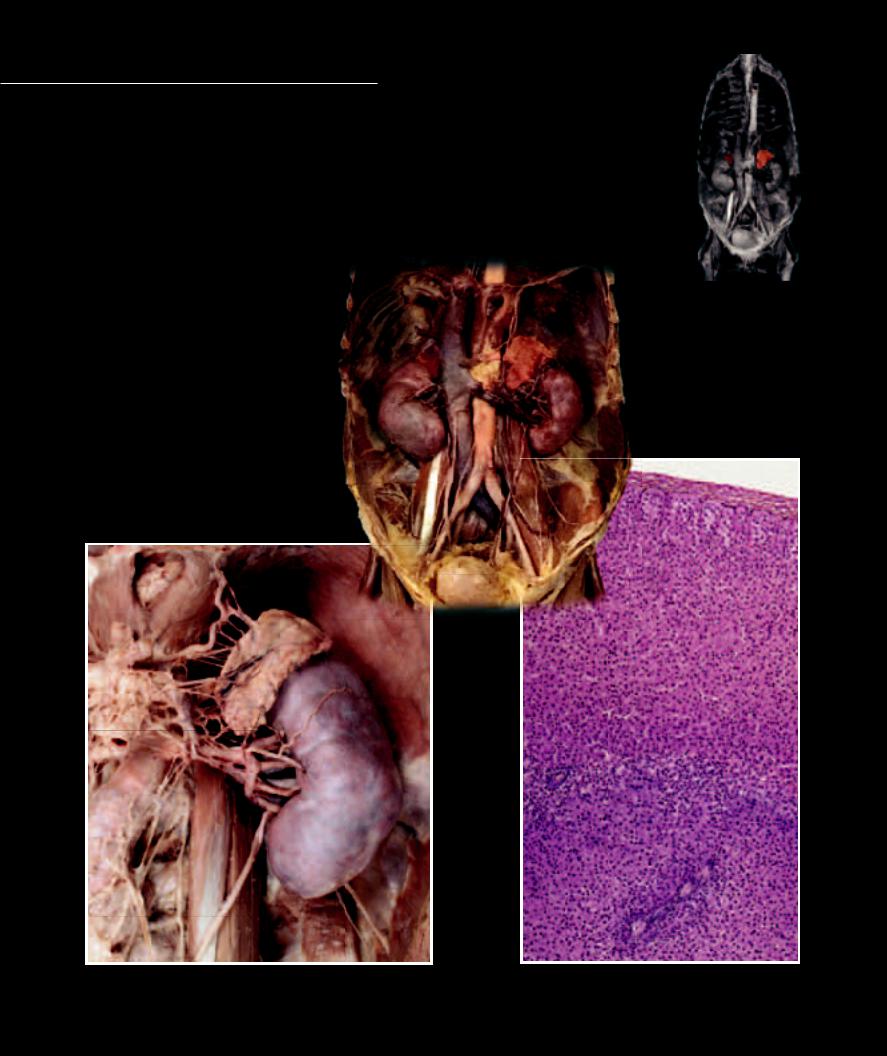
There are two yellowish suprarenal or adrenal glands that sit on the superior end of the kidneys. Each gland is surrounded by a thin connective
tissue envelope. These highly vascular organs are not symmetrical. The right suprarenal gland is slightly smaller and forms a fl at tetrahedron or four-sided polygon. The left suprarenal gland, like the left kidney, is more superior than the right gland and has a semilunar shape that resembles a fl attened stocking hat placed on the upper end of the kidney. Each suprarenal gland is actually composed of two endocrine organs, one surrounding the other. The inner portion of the gland, called the suprarenal medulla, forms approximately 20% of the organ. The medulla secretes catecholamines. The more massive outer part of the gland, called the suprarenal cortex, secretes a variety of steroid hormones. The two parts of the gland each have different embryonic origins. The suprarenal medulla forms from the embryonic mesoderm, and the suprarenal cortex forms from embryonic neural crest cells.
1 |
Right suprarenal gland |
|
|
9 |
|
2 |
Left suprarenal gland |
|
|
|
|
|
|
|
|
||
3 |
Zona glomerulosa of cortex |
|
|
|
12 |
4 |
Zona fasciculata of cortex |
|
|
|
|
|
|
|
|
||
5 |
Zona reticularis of cortex |
|
|
11 |
|
6 |
Medulla |
|
|
||
|
|
|
|
||
7 |
Capsule |
|
|
15 |
2 |
8 |
Kidney |
1 |
|
||
|
|
|
|||
9 |
Aorta |
|
|
16 |
|
10 |
Inferior vena cava |
|
10 |
|
|
|
|
|
|||
11 |
Crura of diaphragm |
8 |
|
|
19 |
12 |
Diaphragm |
|
|
||
|
|
|
|||
13 |
Psoas major muscle |
|
|
9 |
|
14 |
Bladder |
|
|
|
|
|
|
|
|
||
15 |
Celiac artery |
|
|
|
17 |
16 |
Superior mesenteric artery |
|
|
|
|
|
|
|
|
||
17 |
Ureter |
|
|
|
13 |
18 |
Common iliac artery |
|
|
18 |
|
|
|
|
|||
19Renal vein and artery
20Autonomic nerve plexus
14
11
11
2 |
Deep dissection of abdomen |
Anterior view |
15 |
20 |
20
16
19 |
8 |
|
13
20
17
7
3
4
5
6
Left suprarenal gland |
Photomicrograph of suprarenal gland |
Anterior view |
100x |
256
